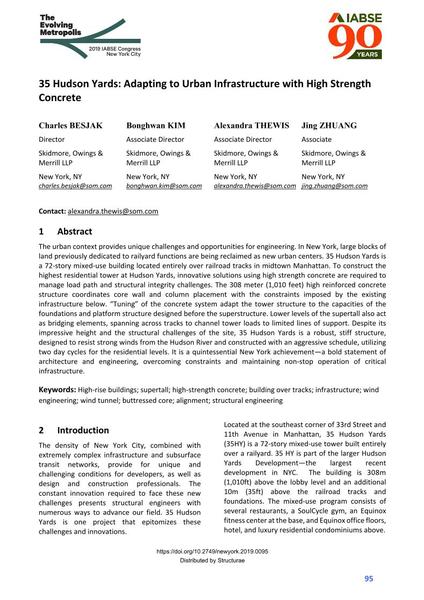35 Hudson Yards: Adapting to Urban Infrastructure with High Strength Concrete

|
|
|||||||||||
Détails bibliographiques
| Auteur(s): |
Charles Besjak
(Skidmore, Owings & Merrill LLP)
Bonghwan Kim (Skidmore, Owings & Merrill LLP) Alexandra Thewis (Skidmore, Owings & Merrill LLP) Jing Zhuang (Skidmore, Owings & Merrill LLP) |
||||
|---|---|---|---|---|---|
| Médium: | papier de conférence | ||||
| Langue(s): | anglais | ||||
| Conférence: | IABSE Congress: The Evolving Metropolis, New York, NY, USA, 4-6 September 2019 | ||||
| Publié dans: | The Evolving Metropolis | ||||
|
|||||
| Page(s): | 95-101 | ||||
| Nombre total de pages (du PDF): | 7 | ||||
| DOI: | 10.2749/newyork.2019.0095 | ||||
| Abstrait: |
The urban context provides unique challenges and opportunities for engineering. In New York, large blocks of land previously dedicated to railyard functions are being reclaimed as new urban centers. 35 Hudson Yards is a 72-story mixed-use building located entirely over railroad tracks in midtown Manhattan. To construct the highest residential tower at Hudson Yards, innovative solutions using high strength concrete are required to manage load path and structural integrity challenges. The 308 meter (1,010 feet) high reinforced concrete structure coordinates core wall and column placement with the constraints imposed by the existing infrastructure below. “Tuning” of the concrete system adapt the tower structure to the capacities of the foundations and platform structure designed before the superstructure. Lower levels of the supertall also act as bridging elements, spanning across tracks to channel tower loads to limited lines of support. Despite its impressive height and the structural challenges of the site, 35 Hudson Yards is a robust, stiff structure, designed to resist strong winds from the Hudson River and constructed with an aggressive schedule, utilizing two day cycles for the residential levels. It is a quintessential New York achievement—a bold statement of architecture and engineering, overcoming constraints and maintaining non-stop operation of critical infrastructure. |
||||
| Mots-clé: |
bâtiments hauts soufflerie
|
||||
